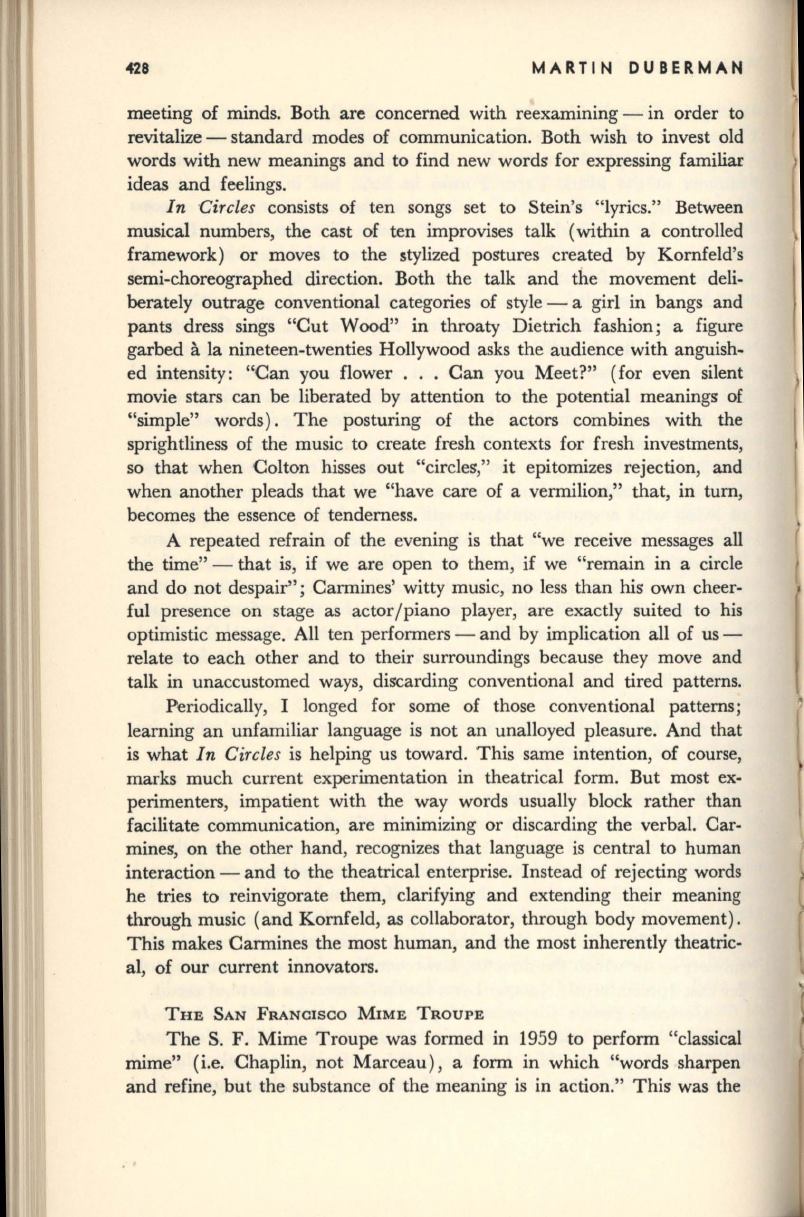
428
MARTIN DUBERMAN
meeting of minds. Both are concerned with reexamining - in order to
revitalize - standard modes of communication. Both wish to invest old
words with new meanings and to find new words for expressing familiar
ideas and feelings.
In Circles
consists of ten songs set to Stein's "lyrics." Between
musical numbers, the cast of ten improvises talk (within a controlled
framework) or moves to the stylized postures created by Kornfeld's
semi-choreographed direction. Both the talk and the movement deli–
berately outrage conventional categories of style - a girl in bangs and
pants dress sings "Cut Wood" in throaty Dietrich fashion; a figure
garbed
a
la nineteen-twenties Hollywood asks the audience with anguish–
ed intensity: "Can you flower ... Can you Meet?" (for even silent
movie stars can be liberated by attention to the potential meanings of
"simple" words). The posturing of the actors combines with the
sprightliness of the music to create fresh contexts for fresh investments,
so that when Colton hisses out "circles," it epitomizes rejection, and
when another pleads that we "have care of a vermilion," that, in turn,
becomes the essence of tenderness.
A repeated refrain of the evening is that "we receive messages all
the time" - that is, if we are open to them, if we "remain in a circle
and do not despair"; Carmines' witty music, no less than his own cheer–
ful presence on stage as actor/piano player, are exactly suited to his
optimistic message. All ten performers - and by implication all of us–
relate to each other and to their surroundings because they move and
talk in unaccustomed ways, discarding conventional and tired patterns.
Periodically, I longed for some of those conventional patterns;
learning an unfamiliar language is not an unalloyed pleasure. And that
is what
In Circles
is helping us toward. This same intention, of course,
marks much current experimentation in theatrical form. But most ex–
perimenters, impatient with the way words usually block rather than
facilitate communication, are minimizing or discarding the verbal. Car–
mines, on the other hand, recognizes that language is central to human
interaction - and to the theatrical enterprise. Instead of rejecting words
he tries to reinvigorate them, clarifying and extending their meaning
through music (and Kornfeld, as collaborator, through body movement) .
This makes Carmines the most human, and the most inherently theatric–
al, of our current innovators.
THE SAN FRANCISCO MIME TROUPE
The S. F. Mime Troupe was formed in 1959 to perform "classical
mime" (i.e. Chaplin, not Marceau), a form in which "words sharpen
and refine, but the substance of the meaning is in action." This was the


